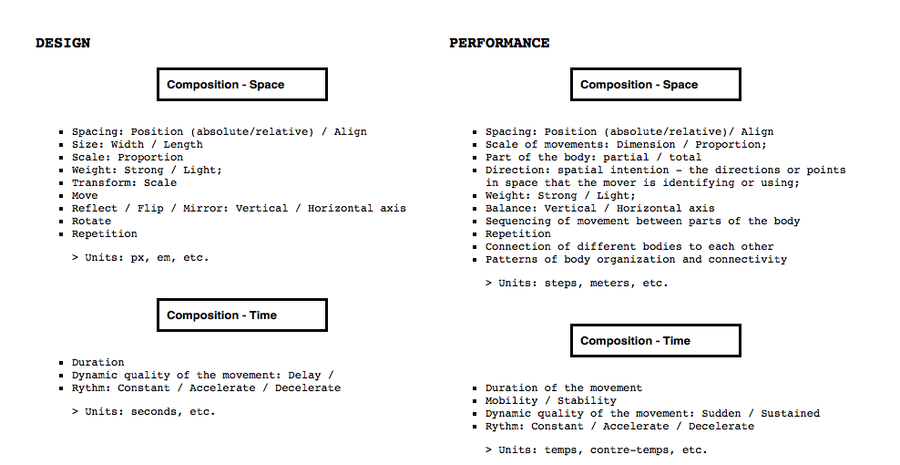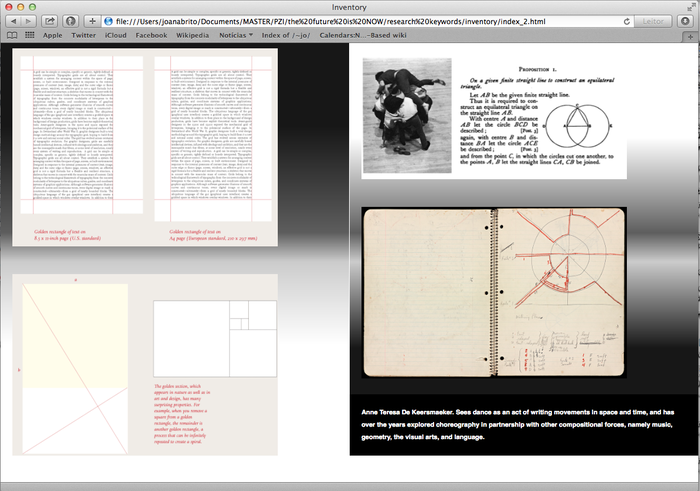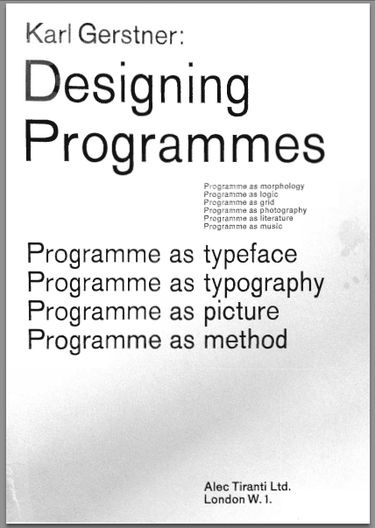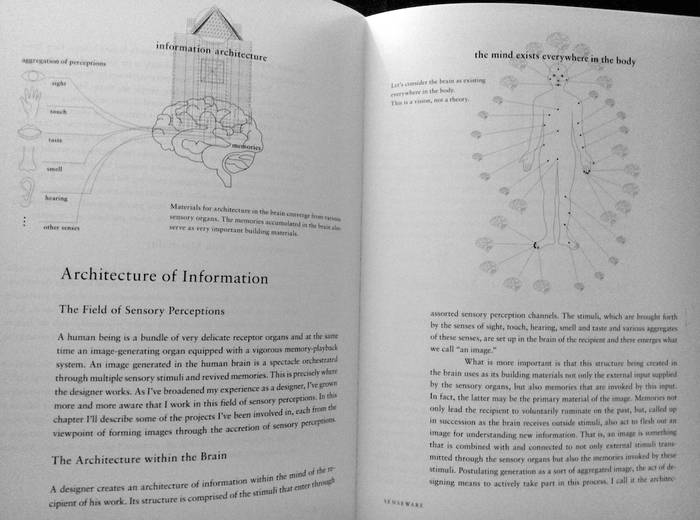Joana's Chapters: Difference between revisions
No edit summary |
No edit summary |
||
| Line 36: | Line 36: | ||
The first successful and widely spread form of dance notation was invented by Pierre Beauchamps, in the late 17th century. It was also defined by a horizontal grid, which positioned the body as a vertical and singular entity traveling across the grid. | The first successful and widely spread form of dance notation was invented by Pierre Beauchamps, in the late 17th century. It was also defined by a horizontal grid, which positioned the body as a vertical and singular entity traveling across the grid. | ||
In Choreography many attempts for universal languages were developed for example Labanotation or Kinetography Laban, a notation system developed by Rudolf Laban, which could be used to describe movement in terms of spatial models and concepts. Around the same time, in 1940, appeared another system Benesh Movement Notation (also known as Benesh notation or choreology) invented by Joan and Rudolf Benesh. Despite this systems being used still this days in education in dance and choreographic practice, most choreographers develop there own way of communicating movement. | In Choreography many attempts for universal languages were developed for example [https://en.wikipedia.org/wiki/Labanotation Labanotation or Kinetography Laban], a notation system developed by Rudolf Laban, which could be used to describe movement in terms of spatial models and concepts. Around the same time, in 1940, appeared another system [https://en.wikipedia.org/wiki/Benesh_Movement_Notation Benesh Movement Notation] (also known as Benesh notation or choreology) invented by Joan and Rudolf Benesh. Despite this systems being used still this days in education in dance and choreographic practice, most choreographers develop there own way of communicating movement. | ||
The 60’s and 70’s, were a time for re-defining choreography as methodology, as well as for questioning the fundamentals of movement and the expression of the body. Choreographers from the late twentieth century of this post-modern movement in dance carried radical and highly experimental performance practices, bringing new formal and aesthetic innovation to the dance field. For this text I will mostly further mention references from this period of time. | The 60’s and 70’s, were a time for re-defining choreography as methodology, as well as for questioning the fundamentals of movement and the expression of the body. Choreographers from the late twentieth century of this post-modern movement in dance carried radical and highly experimental performance practices, bringing new formal and aesthetic innovation to the dance field. For this text I will mostly further mention references from this period of time. | ||
Revision as of 18:32, 7 February 2016
ONE
PART 1.
The Common Ground
The common structures: Composition (time and space)
Design and Performance both rely on compositional decisions on how to organize and distribute elements in space, how these elements relate to each other and to the whole. How they inherently set a specific rhythm and flow to the outcome, which is then perceived in the moment in which is accessed/performed.
Composition is often used interchangeably with various terms such as design, form, visual ordering, or formal structure, depending on the context. Choreography is a specific type of composition. I understand choreography as a creative and structural tool, which uses a combination of written languages to describe movement. The term has also been applied to different contexts, as a metaphor, acknowledging movement as a strong intervening factor in different fields of study and of operation.
“The term ‘choreography has gone viral. In the last five years it has suddenly mobilized as a general referent for any structuring movement, not necessarily the movement of human beings. Choreography can stipulate both the kinds of actions performed and their sequence or progression. (…) Sometimes designating minute aspects of movement, or alternatively, sketching out the broad contours of action within which variation might occur, choreography constitutes a plan or score according to which movement unfolds. Building choreograph space and people’s movement throughout them. (…) Web services choreograph interfaces; and even existence is choreographed. Choreography, then would seem to apply to the structuring of movement in highly diverse diverse occasion, yet always where some kind of order ir desired to regulate that movement,“ - Susan Leigh Foster 2
The common languages:
Design and Performance pieces are a product of a process, by which general rules and concepts are represented by means of abstract structures. When describing a concept or a phenomenon, both mathematics (geometry) and linguistics are commonly used at communicating the position of elements, properties of space, and time attributes.
In graphic design history, composition has been tied to grid systems, which have been the main structural design tool to establish order within the elements to be displayed. A grid is a two-dimensional structure, an intersection of vertical, horizontal lines, or even angular lines, which are used as reference to apply the real content in it.
Grids are perceived as fixed structures, but in fact these structures can be scaled based in defined proportions, by using relative units, like percentages, instead of absolute units such as pixels or points. This technique is particularly used in responsive web design, turning the layout into a flexible structure. Often modular scale is used for the same purpose, in which multiple subdivision of page is made to best adapt the form to the content.
( *By page I mean both the webpage and the print one. Desktop/ hybrid publishing. )
The first successful and widely spread form of dance notation was invented by Pierre Beauchamps, in the late 17th century. It was also defined by a horizontal grid, which positioned the body as a vertical and singular entity traveling across the grid.
In Choreography many attempts for universal languages were developed for example Labanotation or Kinetography Laban, a notation system developed by Rudolf Laban, which could be used to describe movement in terms of spatial models and concepts. Around the same time, in 1940, appeared another system Benesh Movement Notation (also known as Benesh notation or choreology) invented by Joan and Rudolf Benesh. Despite this systems being used still this days in education in dance and choreographic practice, most choreographers develop there own way of communicating movement.
The 60’s and 70’s, were a time for re-defining choreography as methodology, as well as for questioning the fundamentals of movement and the expression of the body. Choreographers from the late twentieth century of this post-modern movement in dance carried radical and highly experimental performance practices, bringing new formal and aesthetic innovation to the dance field. For this text I will mostly further mention references from this period of time.
During this turn in dance history, choreographer brought new forms of speech to choreography. The choreographer Wiiliam Foresythe´s notion that choreography is a ‘class of ideas’, with the idea being ‘a thought or suggestion as to a possible course of action’, somehow deconstructs the previous standardized vocabulary of movements from for examples the Feuillet notation.
Choreography became a process not only for composing innovative dance pieces but an opportunity for the choreographer to speak, a voice, a vehicle for expressing issues for both individual and universal concern. “Everyday movements became dance, and dance became everyday” 2 , essentially non-technical movement was primarily explored, as opposed to the former dance standards.
The american dancer, choreographer and film-maker Yvonne Rainner would emphasize the simplicity of movements, and its proximity to everyday moves, leading to spontaneous and unpretentious choreographies. Anne Teresa De Keersmaeker, a belgium choreographer, followed similar principles, only focussing further on repetition: in the dance piece Rosas Danst Rosas “the movements seem to be very personal, private , idiosyncratic, (..) seemingly endless repetition. This is a play of surfaces rather than an expression of depth. The minimalist monotony of the repetition of mundane gestures suggest compulsion to conform prescribed behavior.“ 3 A difference between the two choreographer could be that Rainner not only added minimalistic movements to her choreographies, but also an anti-spectacale approach to dance. She would avoid the exhibitionism typical from other dance modes: “the body - its actual weight, mass, and unenhanced physicality” 3 Rainer’s intention seems to be to have reduced movement to the simple phenomenological experience of mundane physical activity. This reduction of movement, is related to a the concept brought by Rainer's '60s rhetoric on economy of energy. She is concerned with the body's "energy resources"; with "conserving (actual) energy." Choreographic thought seems to be in parallel level to the design pursuit of shape driven by its functional role, and operating within an economic stance. In the words of the japanese designer Kenya Hara “Design is not the act of amazing an audience with the novelty of forms or materials, it is the originality that repeatedly extract astounding ideas the crevices of the very commonness of everyday life.”
Other approaches to choreography would include the incorporation of variation and chance. Merce Cunningham’s, american choreographer, who often collaborated with John Cage, developed compositional processes which challenged the modern conception of dance in a different way, as “an inner subjectivity by using chance procedures for devising movement and sequencing events.” 2 Yvonne Rainer would write dance tasks for dancers to follow and perform. This mode of choreographing as short instructions, is very similar to scripts give to computers to read and perform the task. Coincidentally, around the same time, Karl Gestner, a swiss a graphic designer created a new method and approach to design, a design method based on a set of conditions, or hypothesis for designing. Cunningham, Rainner and Gestner embraced ‘operational’ thought similarly to what we could find afterwards applied to computational systems.
Only later on, new experiments with choreographic thought and tools arose, constructing movement together with different media genres and technology, a truly interdisciplinary approach.
For instance, William Forsythe who used scripts, but this time actually applied to technology to generate a choreography out of a list of 135 movements, a vocabulary built in connection with the kinesphere (— the total volume of a body’s potential movement). “It’s like rapidly scrolling through a list of names in a computer program.” Forsythe’s methods of choreography are strikingly algorithmic and give rise to a style of movement and interaction that is distinctively his own.
The same convergence of design and technology can be seen evolving in different ways in design practices, to mention again Kenya Hara “Design is not subordinate to media, design explores the essence of media.”
About movement:
“…choreographing our gestures, habits, language, thoughts, tastes and desires.” (…) “By moving (or by opting to remain still) dance demonstrates how its decodings are not mere conceptual propositions but actual possibilities for action.” 2
Choreography doesn’t imply the presence of the body, it is prior to that encounter. It is a visual grammatical formulation which presents a potential movement sequence, a potential scenario for a body to be in space. I believe also design can be driven by the same principles of the potentiality of movement and the presence of the body. A user of a design object, being a page of book or a webpage, will be presented to a space, physical or digital, and will have to ‘move’ through the information it contains.
Even if I am not considering the movement of the body at the same extent that choreography does, I believe it can still be applied in different ways either conceptually and practically to design processes. This can be thought in relation to the dynamics of new media and networked spaces, one moves through time and space, or in relation to actual movement: conventionalized versus natural movement. The use of movement in this case is more concerned with a series of micro body movements. But while these movements are almost imperceptible, our perception is on the other hand being highly stimulated.
“The idea that there is such a thing as fixed form is actually as much an assumption about perception as it is an assumption about art. It assumes that vision is not dynamic – that it is a passive, transparent registering of something that is just there, simply and inertly. If vision is stable, then to make art dynamic you have to add movement. But if vision is already dynamic, the question changes. It’s not an issue of movement or no movement. The movement is always there in any case. So you have to make distinctions between kinds of movement, kinds of experiential dynamics, and then ask what difference they make. (pp.3) - ...all visual perception is “virtual.” It’s a point Alva Noë makes. (...) ..without the actual action -- action appearing in potential. (...) we abstractly see potential, we implicitly see a life dynamic, we virtually live relation. An object’s appearance is an event, full of all sorts of virtual movement. It’s real movement, because something has happened: the body has been capacitated.” - Massumi wiki
I will use choreography to reflect on spatial and body awareness, and how movement is then distributed within carious time values. Design can deeper integrate such variables and develop further on how knowledge is achieved by the interrelation between brain - body - world.
The philosopher Alva Noë investigates the structures of experience and consciousness presenting movement as the "basis of accessibility", allowing humans into "achieving access to the environment". Motion as "sensory motor understanding is what brings the world into focus for consciousness." Noë highlights the fact that motion relies on a "temporally extended involvement", which enhances sensorial perception and consequently produces sensorial change: "transformations that happens in you while you go across the process; what is that transformation? Is understanding, is seeing connections, is knowing your way around."
In dance, along with similar kinesthetic experiences, the human body reaches an intense sensorial perceptual experience, composed of information from many places in the body, finding the need to have an understanding of/ control over of sensory consequences of their own movement. The designer Kenya Hara shares a holistic (body and mind) view on designing “While dealing with shape, color, material, ad texture is one of the more important aspects of design, there is one more: its not the question of how to create, but how to make someone sense something We might call this creative awakening of the human sensors: the design of senses. (p.68) … The physicist Hermann Ludwig Helmholtz (1821-1894) said, “Everything is an event on the skin” Come to think of it, the sense of sight is the response to the stimulus of light on the retina, a circular membrane of 4cm diameter. The sense of hearing is likewise to movement of air (…) All human perception originates in the responses of membranes to things physical, stimulation transmitted to the brain through the nervous system. (p.100)
Movement together with sense experience can be highlighted in design thinking and while producing design.
Rainer once described her dance project as "thinking of oneself in dancing as a neutral purveyor of information." (mediating Trio A text)
Designing and Choreographing are both formal structures, which deal with the concepts of time and space, like holding devices for something yet to be seen, or experienced. In Kenya Hara’s words “… it holds emptiness or nothingness within… (p.413)”
List of References
1. http://www.wired.com/1996/10/schiphorst-2/ Thecla Shiphorst - Life Forms 2. MOVE. Choreographing you. Art and Dance since the 1960’s. 3. Of the presence of the body - https://en.wikipedia.org/wiki/Postmodern_dance
Key Concepts
Choreographic Thinking / Intensify perception / Organic Functionalism / Corporeality / Presence
// Perception as Action (maybe the difference between my approach and Kenya Hara’s) - to re integrate visual perception with the body as a whole. “The body (…) is a cause of sensations. It is more than an instrument for action: it contributes to the life of consciousness and memory in a psyco-phisical parallelism of processes that assume meaning and relief only when they are connected.” - Lea Vergine “Body Art and Performance - the Body as Language”.
TWO
PART 2.
“As Michael Klien writes: ‘Choreography is everywhere, always in everything. i no longer see pictures, I see movement and interrelation, exchange and communication between bodies and ideas.” (2 - dance.rtf)
Choreographing Design (!?)
trans-disciplinary a prefix occurring in loanwords from Latin (transcend; transfix); on this model, used with the meanings “across,” “beyond,” “through,” “changing thoroughly,” “transverse,” in combination with elements of any origin.
inter-disciplinary 1. a prefix occurring in loanwords from Latin, where it meant “between,” “among,” “in the midst of,” “mutually,” “reciprocally,” “together,” “during” (intercept; interest); on this model, used in the formation of compound words (intercom; interdepartmental). 2.combining or involving two or more academic disciplines or fields of study.
meta-phor 1. from Latin, from Greek metaphora, from metapherein to transfer, from meta- + pherein to bear. 2. a figure of speech in which a word or phrase is applied to an object or action that it does not literally denote in order to imply a resemblance. at http://dictionary.reference.com/browse/
“Because the metaphors are transfer devices conduits for meaning from one frame of reference to another, metaphor may itself offer a discourse of translation between the traditions, debates, and objects of study of separate disciplinary domains. (…) In the culture of interface, we live in the realm of metaphor. An interrogation of the cultural valences of metaphor may build ‘bridges’ (another metaphor) between the disciplines of philosophy, art history, film studies, and new media studies..” The Virtual Window - from Alberti to Microsoft - Anne Friedberg.
“fusions” // relational “compositions” // cross-referencing // hybrid // transcend boundaries // “trans” (across, or dynamic movement of crossing)
A new piece emerges out of a new composition.
WHAT ARE THE NEW CONDITIONS FOR DESIGNING?
The sociologist Pierre Bourdieu has termed this type of quasi-automatic knowledge 'sens pratique' a practical sense, describing everyday situations as 'structured improvisation' or social choroegraphies. (pp.29) The concept of knowledge society emphasizes the close link between modernization and mechanization. Thus, information and communication technologies have not only been the motor behind accelerated knowledge production and globe knowledge dissemination, they have also fostered the transformation of knowledge: knowledge in knowledge-based societies is fast-moving transient- just like dance. It is generated and it disappears rapidly; we only need to think of websites. The sociologist Zygmunt Bauman described transience as the key metaphor for our times. Everything previously stable and reliable dissolves in this 'liquid modernity'. It floats by, as Bauman says: Fluid travel easily. They flow, spill, run out, splash, pour over, leak, flood, spray, drip, seep, ooze (...) The extraordinary mobility of fluids makes us associate them with the idea of lightness. (...) We associate lightness or weightiness with mobility and inconstancy. (Dance in Knowledge Society - Gabriele Klein - wiki)
ephemera phenomena
movement (and its absence) evoke the political dimension of the ephemeral.
minimal and decorative
ecology and technology
physical features of the body and physical features of technology.
qualities of technology: immediacy / instantaneity
body relating to its own conditions. assuming unexpected circumstance, which also requires the intensification of energy flows, so that aesthetics, politics, and corporeality may fuse in the formation of more potent subjectivities. articulation with the body as unit. “The body remains the enduring reality (..) by enduring , it can resist normative social and aesthetic ideologies”, towards a transformation of bodies into sites of resistance? - from dance essay - (ref.3) Basic concepts of body movement
“Hyper accelerated” and regimented modes of experiencing temporality take over and determine our individual rhythm of life. Time becomes essential. How can we respond with other modes of extending, compressing, and distorting temporality? Transform our experience of time/ presence of the body? Digital space and time. The speed of speed. Digitalized time. Network time.
What is our own acceleration, our own movement, vector, line, link?
Current society as being embedded in ever growing abstract and alienated communication structures.
What if the world and the bodies in it operate according to this logic? What if perceiver and perceived are mutually defining?
…incorporating temporality / ephemerality / … in the design vocabulary
To propose a re-articulation, at a much more fundamental level: choreo-design. co-formation of compositional and thematic concerns. Make invisible forces (elements of choreography) appear as physical manifestations of design / kinetic assemblage of body and matters.
Designing as choreographic decisions. // construction or deconstruction of choreographic and performative strategies’?
a fluid, distributed, indeterminate interaction between human and nonhuman actors in a dynamic, emerging ecology. (in)corporeality, virtuality, creativity and technicity
temporal processes - - - - -
Design and choreography as formal structures, the frameworks, Ultimately it deals with empty space interlaced with information, or movement with pause, black and white, silence and noise, like a binary system.
List of References
1. Designing Design - Kenya Hara
2. Typorama, The Graphic Work of Philippe Apeloig - Thames & Hudson, 2013
3. http://www.internetagemedia.com/manifesto/
4. What we do is secret: Paul Virilio Planetary, and data visualization. http://www.bratton.info/projects/texts/what-we-do-is-secrete/
5. The Virtual Window - from Alberti to Microsoft - Anne Friedberg.
6.PZI





